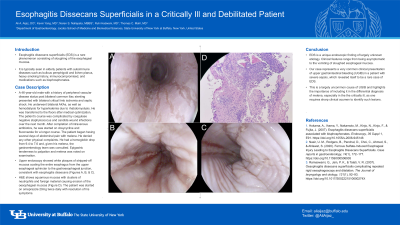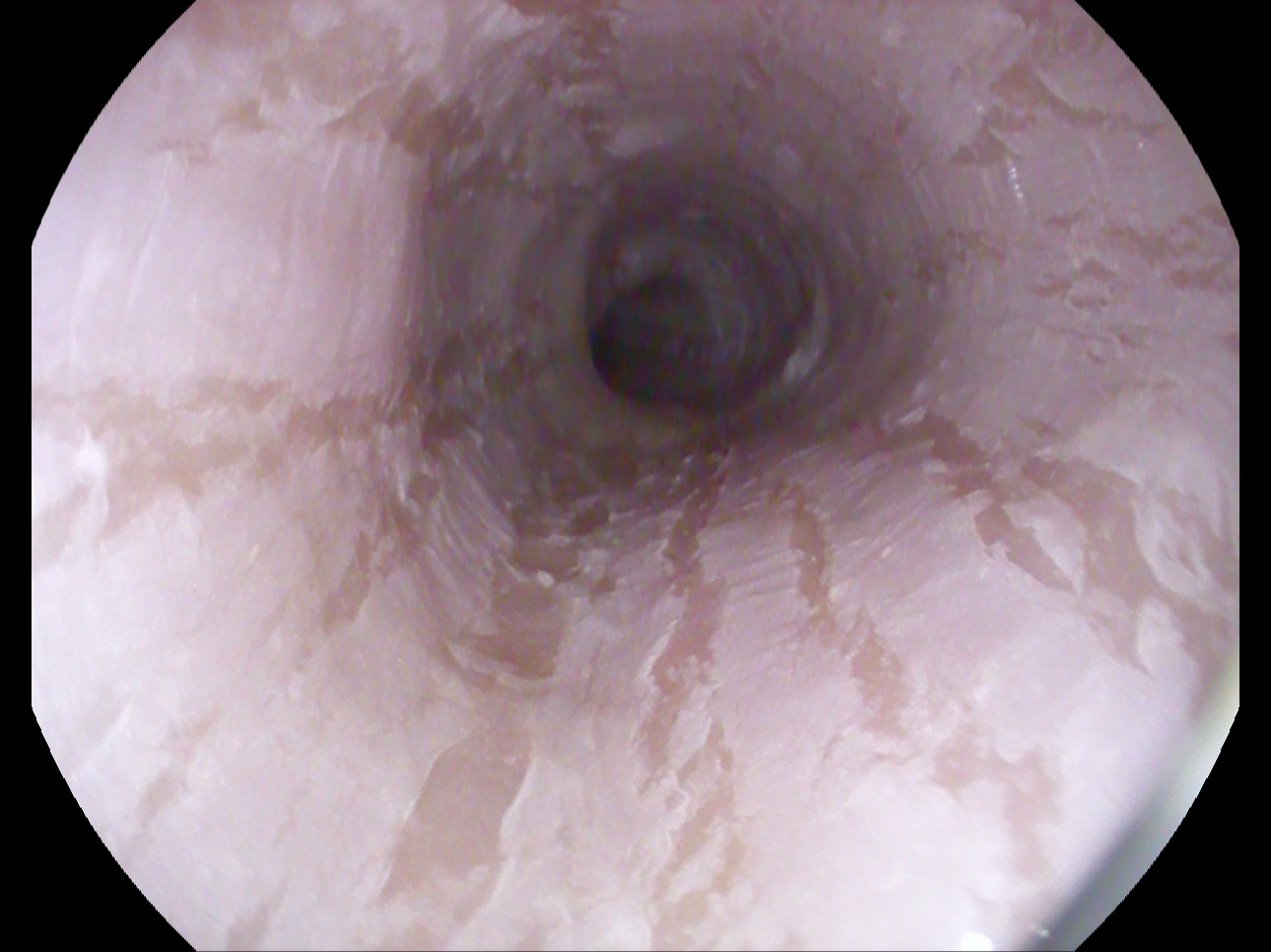Monday Poster Session
Category: Esophagus
P1864 - Esophagitis Dissecans Superficialis in a Critically Ill and Debilitated Patient
Monday, October 23, 2023
10:30 AM - 4:15 PM PT
Location: Exhibit Hall

Has Audio
- AA
Ali A. Aijaz, DO
University at Buffalo
Buffalo, NY
Presenting Author(s)
Ali A.. Aijaz, DO, Kevin Yang, MD, Naren S. Nallapeta, MBBS, Ruhi Hadwani, MD, Thomas C. Mahl, MD
University at Buffalo, Buffalo, NY
Introduction: Esophagitis dissecans superficialis (EDS) is a rare phenomenon consisting of sloughing of the esophageal mucosa. It is typically seen in elderly patients with autoimmune diseases such as bullous pemphigoid and lichen planus, heavy smoking history, immunocompromised, and medications such as bisphosphonates. We describe a case of EDS in a 46-year-old male initially admitted for bilateral limb ischemia requiring bilateral above-the-knee amputation (AKA) who subsequently developed abdominal pain and melena.
Case Description/Methods: A 46-year-old male with a history of peripheral vascular disease status post bilateral common iliac stenting presented with bilateral critical limb ischemia and septic shock after being found unresponsive at home. He underwent bilateral AKAs, as well as hemodialysis for hyperkalemia secondary to rhabdomyolysis. He was stabilized and transferred to the floors after medical optimization. The patient’s course was complicated by coagulase negative staphylococcus and candida wound infections over the next month. After completion of intravenous antibiotics, he was started on doxycycline and fluconazole for a longer course. The patient began having several days of abdominal pain with melena. He denied any other physical complaints. He had a hemoglobin drop from 9.4 to 7.6 and, given his melena, the gastroenterology team was consulted. Epigastric tenderness to palpation and melena was noted on examination. Upper endoscopy showed white plaques of stripped-off mucosa coating the entire esophagus from the upper esophageal sphincter to the gastroesophageal junction, consistent with esophagitis dissecans (see figure). Biopsies showed splitting of squamous epithelium at different levels with a hyperplastic basal layer but minimal inflammation. The patient was started on omeprazole 20mg twice daily with resolution of his symptoms.
Discussion: EDS is a unique endoscopic finding of largely unknown etiology. Clinical features range from being asymptomatic to the vomiting of sloughed esophageal mucosa. Our case represents a very common clinical presentation of upper gastrointestinal bleeding (UGIB) in a patient with severe sepsis, which revealed itself to be a rare case of EDS. This is a largely uncommon cause of UGIB and highlights the importance of including it in the differential diagnosis of melena, as one requires sharp clinical acumen to identify such lesions.

Disclosures:
Ali A.. Aijaz, DO, Kevin Yang, MD, Naren S. Nallapeta, MBBS, Ruhi Hadwani, MD, Thomas C. Mahl, MD. P1864 - Esophagitis Dissecans Superficialis in a Critically Ill and Debilitated Patient, ACG 2023 Annual Scientific Meeting Abstracts. Vancouver, BC, Canada: American College of Gastroenterology.
University at Buffalo, Buffalo, NY
Introduction: Esophagitis dissecans superficialis (EDS) is a rare phenomenon consisting of sloughing of the esophageal mucosa. It is typically seen in elderly patients with autoimmune diseases such as bullous pemphigoid and lichen planus, heavy smoking history, immunocompromised, and medications such as bisphosphonates. We describe a case of EDS in a 46-year-old male initially admitted for bilateral limb ischemia requiring bilateral above-the-knee amputation (AKA) who subsequently developed abdominal pain and melena.
Case Description/Methods: A 46-year-old male with a history of peripheral vascular disease status post bilateral common iliac stenting presented with bilateral critical limb ischemia and septic shock after being found unresponsive at home. He underwent bilateral AKAs, as well as hemodialysis for hyperkalemia secondary to rhabdomyolysis. He was stabilized and transferred to the floors after medical optimization. The patient’s course was complicated by coagulase negative staphylococcus and candida wound infections over the next month. After completion of intravenous antibiotics, he was started on doxycycline and fluconazole for a longer course. The patient began having several days of abdominal pain with melena. He denied any other physical complaints. He had a hemoglobin drop from 9.4 to 7.6 and, given his melena, the gastroenterology team was consulted. Epigastric tenderness to palpation and melena was noted on examination. Upper endoscopy showed white plaques of stripped-off mucosa coating the entire esophagus from the upper esophageal sphincter to the gastroesophageal junction, consistent with esophagitis dissecans (see figure). Biopsies showed splitting of squamous epithelium at different levels with a hyperplastic basal layer but minimal inflammation. The patient was started on omeprazole 20mg twice daily with resolution of his symptoms.
Discussion: EDS is a unique endoscopic finding of largely unknown etiology. Clinical features range from being asymptomatic to the vomiting of sloughed esophageal mucosa. Our case represents a very common clinical presentation of upper gastrointestinal bleeding (UGIB) in a patient with severe sepsis, which revealed itself to be a rare case of EDS. This is a largely uncommon cause of UGIB and highlights the importance of including it in the differential diagnosis of melena, as one requires sharp clinical acumen to identify such lesions.

Figure: Upper endoscopy revealed whitish plaques of stripped-off mucosa throughout the esophagus.
Disclosures:
Ali Aijaz indicated no relevant financial relationships.
Kevin Yang indicated no relevant financial relationships.
Naren Nallapeta indicated no relevant financial relationships.
Ruhi Hadwani indicated no relevant financial relationships.
Thomas Mahl indicated no relevant financial relationships.
Ali A.. Aijaz, DO, Kevin Yang, MD, Naren S. Nallapeta, MBBS, Ruhi Hadwani, MD, Thomas C. Mahl, MD. P1864 - Esophagitis Dissecans Superficialis in a Critically Ill and Debilitated Patient, ACG 2023 Annual Scientific Meeting Abstracts. Vancouver, BC, Canada: American College of Gastroenterology.
